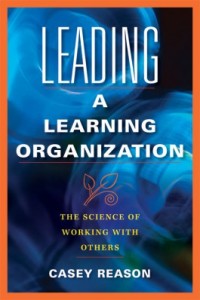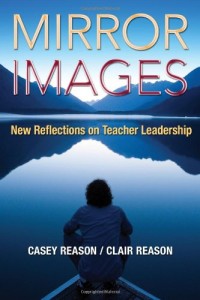A Healthy Dose of Reason
By Patty Gelb
 Beyond a reasonable doubt, Dr. Casey Reason (Education Specialist, ’94) is at the forefront of professional learning communities and virtual collaboration in the United States.
Beyond a reasonable doubt, Dr. Casey Reason (Education Specialist, ’94) is at the forefront of professional learning communities and virtual collaboration in the United States.
So much so, in fact, that the National Education Association (NEA) – the largest professional organization and the largest labor union in America – is sharing a chapter of his latest work with 3.2 million educators in this country ranging from kindergarten to higher education.
 Reason’s book, “Professional Learning Communities at Work and Virtual Collaboration: On a Tipping Point of Transformation,” scheduled to be released this summer, was co-authored with Richard DuFour. DuFour is recognized as one of the leading authorities on aiding schools and their administrators in implementing the professional learning communities’ process.
Reason’s book, “Professional Learning Communities at Work and Virtual Collaboration: On a Tipping Point of Transformation,” scheduled to be released this summer, was co-authored with Richard DuFour. DuFour is recognized as one of the leading authorities on aiding schools and their administrators in implementing the professional learning communities’ process.
Professional learning communities is a system that K-12 schools can adopt to change the way teachers work. Without a collaborative system in place, like professional learning communities, teachers could work alone as almost a free agent — managing their classrooms, teaching students, planning lessons and grading papers. Beyond faculty meetings to discuss issues, a teacher could be fairly isolated.
“In the era of accountability where we have to be consistent with what we present, professional learning communities asks that teachers meet consistently, share their approaches, share lesson plans and share data,” said Reason. “Common assessments are developed within the PLC structures so that all of the teachers use the same test within a similar time frame. They may find out that one teacher is able to bring more students to standard more consistently than another teacher. It is a way to ensure that every student is served, supported, and it allows teachers to work more collaboratively.”
Professional learning communities is not a new concept. It is used in many schools nationwide to facilitate teachers into working groups. Technology advances and the opportunities it could create in this field was an interest to Reason. The former teacher, assistant principal, principal, assistant superintendent, virtual course developer, consultant and author of award-winning educational books had been researching the effects social media and technology was having on education.
“The middle of last year, I approached my publisher with the idea of publishing a book on the topic of how professional learning communities were evolving because of technology,” said Reason. “I have worked with virtual learning for many years now, since the early 2000s. What we are learning about social media and virtual learning, and just the power to connect, is changing how people work in teams and what they are capable of.”
His publisher suggested that Reason reach out to DuFour about working on the book together. Reason knew DuFour, so he picked up the phone and gave him a call. He shared the concept and within a 15-minute phone call, DuFour was onboard with the project.
“He really liked the idea of a forward thinking book that focused on how technology is changing how people work in teams,” Reason said. “That is how the book got started.”
They spent the better part of the last eight months writing and collaborating. The pair just completed final edits.
“The professional learning community process is based on the premise that educators have expertise that can enhance their individual and collective practice if there is a process to share that expertise,” said DuFour. “The book parts out that this sharing need not be limited to colleagues in your building and can be expanded to include educators from around the world if educators tap into the power of technology.”
This latest book shares a lot of Reason’s most recent research interest; but it has been his experiences over the last 20 years that led him to the position where he is now in his career and those experiences began in Northwest Ohio. He was born in Sandusky to parents Clair “Tuffy” (Education, ’59) and Janice Scott Reason.
The couple met at UT in the spring of ’58 in an education class taught by Dean Kathryn Schwab. Tuffy played for the Rockets as a starting forward on Toledo’s very first Mid-American Conference Championship basketball team. Both went on to become educators; Tuffy an English teacher and Jan a principal.
“The University of Toledo provided the background and training needed to achieve goals we had planned for ourselves,” said Tuffy Reason. “We felt very confident in the classroom because of the excellent training we received from this institution.”
 When Casey was born, his father was a radio broadcaster moving for his job across Ohio and Michigan. The family decided they loved the Toledo area and moved to Maumee. His father became a teacher at Clay High School. His mother became a principal for Toledo Public Schools.
When Casey was born, his father was a radio broadcaster moving for his job across Ohio and Michigan. The family decided they loved the Toledo area and moved to Maumee. His father became a teacher at Clay High School. His mother became a principal for Toledo Public Schools.
Casey Reason first became a teacher, then an administrator. He was an educator for five years in Sylvania when he was offered the position of assistant principal in Findlay. His career continued to progress when he became an associate principal at Washington Local Schools, then the principal at Whitmer High School. Reason was just 30 years old. It was during this time that he decided to attend The University of Toledo to receive his education specialist degree.
“The University had a good and rigorous program,” shared Reason. “There was a personalization about it where there seemed to be genuine concern for people. I still think this is important and I assure you that I still carry that with me with what I do today.”
Upon completion of his degree at UT, this Rocket alumnus continued his meteoric rise in the field of education. He went on to become an assistant superintendent in Northville, Michigan. In 2008, he was offered and became the inaugural chair of leadership studies at Grand Canyon University in Phoenix, Arizona. He wasn’t a stranger to the area having worked with the University of Phoenix over the years in distance and virtual learning and developing online curriculum.
But it was his time as associate principal of Washington Local Schools that helped him start his career as an author.
“When I was at Washington Local, the teachers and staff of the school worked very hard and we made some pretty significant changes and improvements,” said Reason. “After five years together, we ended up winning a special commendation from the State of Ohio for dramatic improvement and achievement in an urban setting. Because of that award, there was interest in how we did it.”
The school was studied and they were part of a reform network to learn how they achieved their success. Several years following, Reason was speaking at a conference when he ran into the president of Solution Tree Publishing.
“I told him a little about my background and what we had done at Washington Local,” Reason shared. “He asked me if I ever considered writing a book and I had. He pulled his cell phone out, called his publisher and said ‘Here is a guy that I really want to write a book for us. I will put him on the phone and I want a contract for him as soon as you can.’ Not quite ten years later I have written five books. I was the keynote speaker at Solution Tree’s biggest conference this year. It’s been a very good relationship and I think we both chose wisely.”
 Reason utilized his education experience to write “Leading a Learning Organization: The Science of Working with Others.” The book was awarded Phi Delta Kappa International’s book of the year selection for 2010. It was also endorsed by best-selling author Ken Blanchard.
Reason utilized his education experience to write “Leading a Learning Organization: The Science of Working with Others.” The book was awarded Phi Delta Kappa International’s book of the year selection for 2010. It was also endorsed by best-selling author Ken Blanchard.
 Following the success of that book, Reason and his father had the opportunity to work together. They co-authored his second book “Mirror Images: New Reflections on Teacher Leadership.”
Following the success of that book, Reason and his father had the opportunity to work together. They co-authored his second book “Mirror Images: New Reflections on Teacher Leadership.”
“I approached my dad and said I thought it would be a good idea to write this book together and he agreed,” said Reason. “It was a great experience and a great opportunity to bond together… I gave him a template and he added to it. Then we took turns editing each other. My dad is an English teacher, well, we are both English teachers. But, he is a better editor than I am.”


Reason went on to write “100 Days to Leadership Impact” in 2011 and “Stop Leading Like It’s Yesterday: Key Concepts for Shaping Today’s School Culture” in 2014.
“With schools, some of the biggest challenges we face are our old, existing paradigms,” Reason said. “In that book (‘Stop Leading Like It’s Yesterday) I talk about the fact that there are so many old paradigms. The fact that we take summers off has everything to do with an old paradigm. The idea that you learn lots of valuable information about a student while working with them for a whole year in elementary, and then pass them on to the next grade with almost no information following them, is an old paradigm that is based on the bureaucracy of the system, not what is good for learning. If you are running a business, there is no way that you would take a client, spend nine months nurturing it, abandon it for three months in the summer, then pass it off to another sales rep with almost no transition. You wouldn’t do that in business, yet we still do it to some degree with students all the time.”
Reason recently transitioned out of the chairmanship at Grand Canyon University to make more time for speaking and writing, but he keeps his hands in teaching as a part-time professor and supports universities in business development efforts. The majority of his schedule is filled as a full-time speaker and consultant. He is incorporated with his own company now.
An important part of Reasons’ world are his twin sons, Brice and Kiah.
“My boys were preemies and were in the Toledo Hospital for a month when they were born,” Reason said. “The doctor that delivered them was the former University of Toledo quarterback, Dr. Kent Bishop. He is a good friend and was great under pressure in bringing my sons into the world. Both boys are now good sized… one of them is almost 6-foot 2-inches. I am about ready to lose the height battle.”
Casey Reason’s parents now live near him and their grandchildren. The author likes to spend as much time as he can outside, hiking whenever possible. He is an elder in his church and spends time traveling all over the world consulting and speaking. One special trip he recalled was a consulting job at a boarding school in Switzerland. He took his sons on that trip, living in the boarding school. His kids got the opportunities to “live above the clouds” for a week. Reason enjoys the opportunities to travel with his boys.
Reason has had great achievement in the field of education and he and DuFour’s new book promises to continue this streak. The book will be available in August of this year and the NEA will be sharing the first chapter of “Professional Learning Communities at Work and Virtual Collaboration: On a Tipping Point of Transformation” to all of its members.
“I don’t think the NEA has ever done anything like what they have offered to do in this project,” said DuFour. “I think it reflects their efforts to bring educators together through technology as a means of helping educators meet the increasing demands that are being placed upon them. We were very proud to partner with the NEA on this venture.”
Reason shares DuFour’s pride in the work they did on the book and the fact that the NEA wants to share it with its membership.
“For the first time in the history of the NEA they’re sending a sample chapter of an author’s new book to ostensibly every teacher in America,” Reason said. “There are 3.2 million people in the NEA and there are another 600,000 in the American Federation of Teachers. A good majority of every teacher in American public schools are going to get a copy of a chapter of our new book.”
His work through the years has made an impact across the U.S. and specifically to the NEA.
“Dr. Casey Reason is exceptionally knowledgeable about online communities and digital engagement,” shared Barbara Hopkins, Ph.D., Sr. Program Specialist at the NEA. “His expertise has aided us greatly at the National Education Association (NEA) in order to build our online professional learning communities. He’s a master trainer, researcher, practitioner and overall great person. His role as a thought partner has greatly benefited us in the development of our strategy and training. It’s been a great joy to work with him on this major initiative for NEA.”
Reason continues to work to improve the learning environment of schools and education for kids. He is very optimistic in the future of education in our nation.
“The fact of the matter is the reason schools haven’t changed much is that we have never run out of business.” Reason said. “General Motors and Ford would not have changed if other companies hadn’t come along and to some degree forced the issue. The point of my new book, however, is that technology is a flattening force that points to an optimistic future. We have got an unbelievably great opportunity to connect kids with resources that are free or nearly free today. Despite what is said in the news, this is a great time to be in education and I am very optimistic about what this new era of technology can mean for kids and the future of our country.”
The University of Toledo Alumni Association received an advanced copy of the first chapter that is being shared through the NEA. To read the chapter, click here.
To order a copy of Reason’s book, click here.
To learn more about Casey Reason and his work you can visit his website at: http://www.caseyreason.com/






